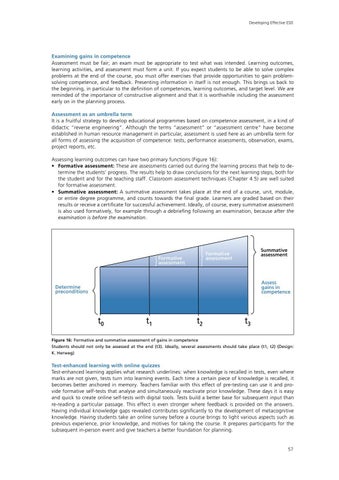Developing Effective ESD
Examining gains in competence Assessment must be fair; an exam must be appropriate to test what was intended. Learning outcomes, learning activities, and assessment must form a unit. If you expect students to be able to solve complex problems at the end of the course, you must offer exercises that provide opportunities to gain problemsolving competence, and feedback. Presenting information in itself is not enough. This brings us back to the beginning, in particular to the definition of competences, learning outcomes, and target level. We are reminded of the importance of constructive alignment and that it is worthwhile including the assessment early on in the planning process. Assessment as an umbrella term It is a fruitful strategy to develop educational programmes based on competence assessment, in a kind of didactic “reverse engineering”. Although the terms “assessment” or “assessment centre” have become established in human resource management in particular, assessment is used here as an umbrella term for all forms of assessing the acquisition of competence: tests, performance assessments, observation, exams, project reports, etc. Assessing learning outcomes can have two primary functions (Figure 16): Formative assessment: These are assessments carried out during the learning process that help to de• termine the students’ progress. The results help to draw conclusions for the next learning steps, both for the student and for the teaching staff. Classroom assessment techniques (Chapter 4.5) are well suited for formative assessment. • Summative assessment: A summative assessment takes place at the end of a course, unit, module, or entire degree programme, and counts towards the final grade. Learners are graded based on their results or receive a certificate for successful achievement. Ideally, of course, every summative assessment is also used formatively, for example through a debriefing following an examination, because after the examination is before the examination.
Summative assessment
Formative assessment
Formative assessment
Assess gains in competence
Determine preconditions
t0
t1
t2
t3
Figure 16: Formative and summative assessment of gains in competence Students should not only be assessed at the end (t3). Ideally, several assessments should take place (t1, t2) (Design: K. Herweg)
Test-enhanced learning with online quizzes Test-enhanced learning applies what research underlines: when knowledge is recalled in tests, even where marks are not given, tests turn into learning events. Each time a certain piece of knowledge is recalled, it becomes better anchored in memory. Teachers familiar with this effect of pre-testing can use it and provide formative self-tests that analyse and simultaneously reactivate prior knowledge. These days it is easy and quick to create online self-tests with digital tools. Tests build a better base for subsequent input than re-reading a particular passage. This effect is even stronger where feedback is provided on the answers. Having individual knowledge gaps revealed contributes significantly to the development of metacognitive knowledge. Having students take an online survey before a course brings to light various aspects such as previous experience, prior knowledge, and motives for taking the course. It prepares participants for the subsequent in-person event and give teachers a better foundation for planning.
57














